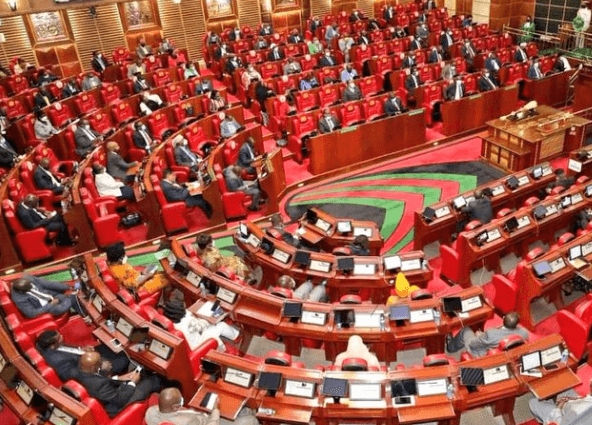
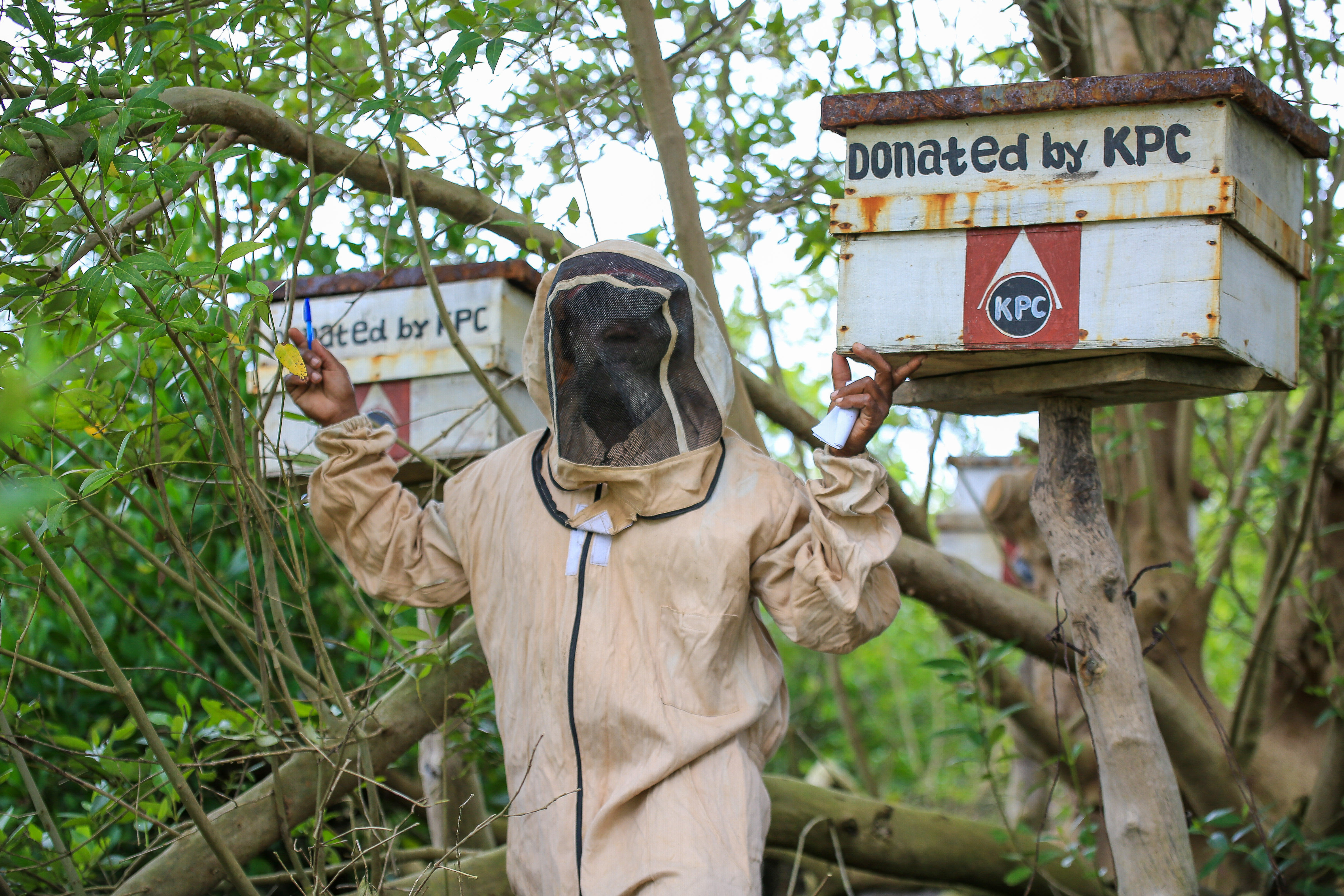 A member of Bidii Creek Conservancy showcases the beehives donated to the group by KPC on July 22, 2025./PHOTO:John Chesoli
A member of Bidii Creek Conservancy showcases the beehives donated to the group by KPC on July 22, 2025./PHOTO:John Chesoli This road divides two historical enclaves: Jomvu Mission on one side, rooted in precolonial Christian heritage, and a settlement of early Muslim converts on the other.
Today, both communities share a story of hope anchored in the verdant mangroves of Tudor Creek.
Perched on a cliff overlooking the tidal expanse is the modest office of Bidii Creek Conservancy, a community-based organisation that anchors the region’s environmental and economic revival.
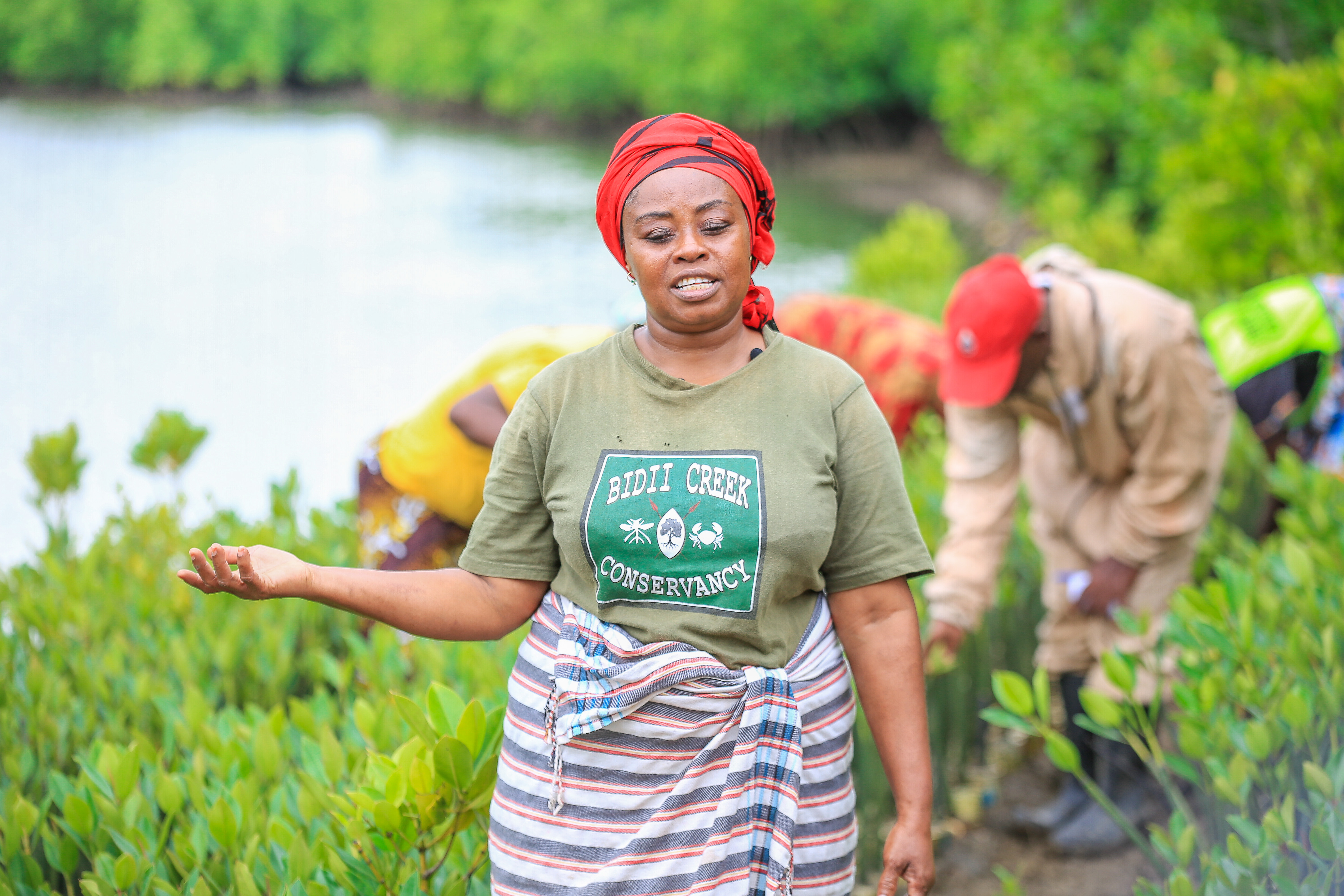 Treasurer Thima Ahmed leads other women in inspecting the mangrove seedlings nursery in Jomvu Kuu along Tudor Creek on July 22, 2025./ PHOTO:John Chesoli
Treasurer Thima Ahmed leads other women in inspecting the mangrove seedlings nursery in Jomvu Kuu along Tudor Creek on July 22, 2025./ PHOTO:John ChesoliWhat began in 2009 as a small youth group tackling local waste has evolved into a force of restoration, with mangrove conservation at its core.
The initiative formalised as a CBO in 2013, but its real momentum arrived in 2021 when the Kenya Pipeline Company Foundation engaged the community to source seedlings for a restoration of degraded mangrove land granted to KPC by Kenya Forest Service.
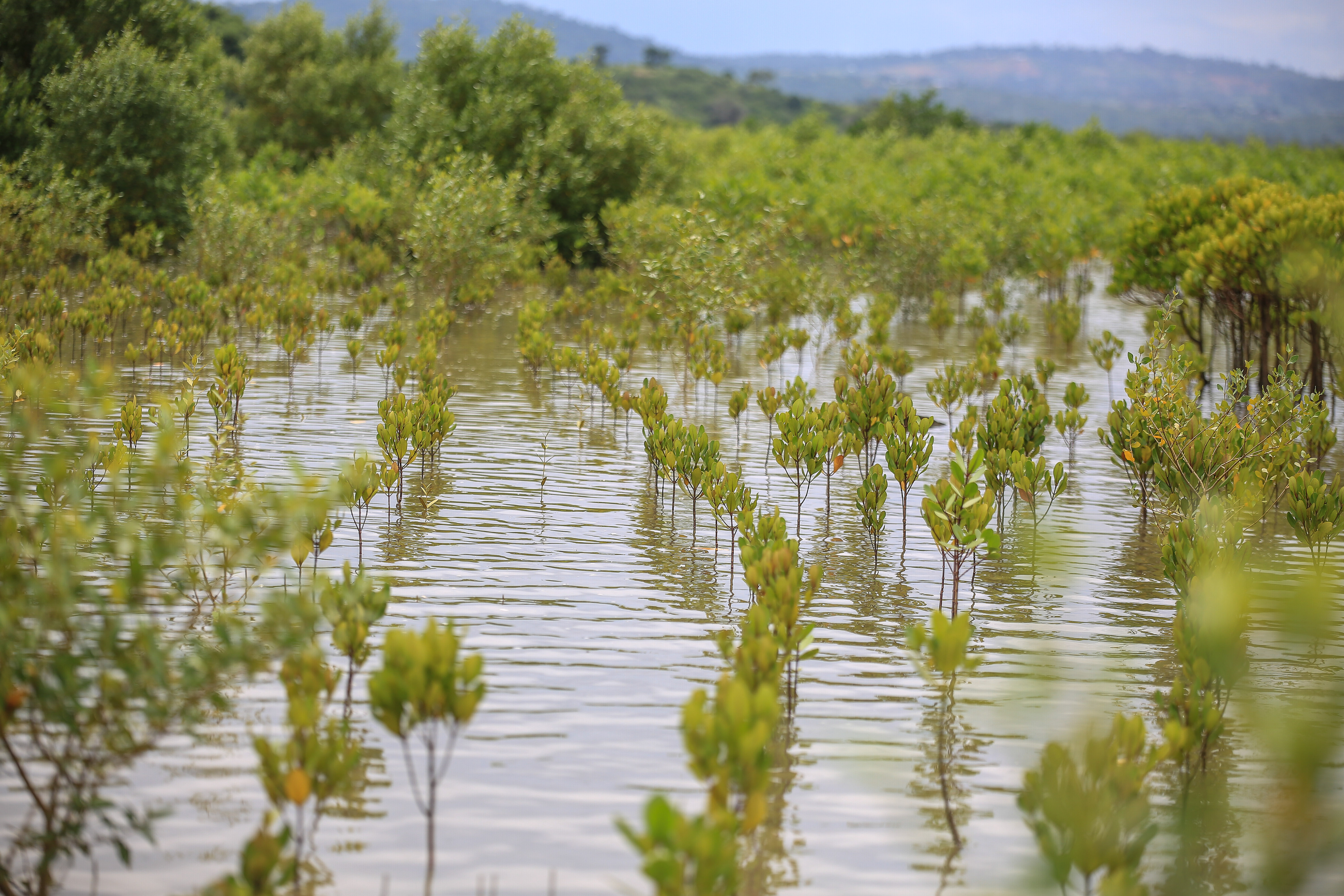 A section of the 50 hectares of mangroves that have been planted by Bidii Creek Conservancy in Jomvu with the assistance of KPC on July 22, 2025/PHOTO:John Chesoli
A section of the 50 hectares of mangroves that have been planted by Bidii Creek Conservancy in Jomvu with the assistance of KPC on July 22, 2025/PHOTO:John Chesoli A season of restoration begins
Aligned with the presidential directive to grow 15 billion trees within a decade, aiming to raise Kenya’s tree cover to at least 10 percent of land area, Kenya Pipeline Company (KPC) has been key in national reforestation efforts in partnership with Kenya Forest Service (KFS), NEMA, schools, and communities along its pipeline corridor.
As of May 2024, KPC had planted 613,141 seedlings nationwide with a survival rate of 93 per cent.
A core component of their environmental restoration programme is mangrove reforestation on Mombasa County’s Jomvu Creek.
KPC adopted 100 hectares of degraded mangrove forest along Tudor Creek.
Over three years, KPC has planted 550,000 mangrove trees on a 50-hectare in Jomvu Kuu along Tudor Creek, in coordination with Bidii Creek Conservancy and other Community Forest Associations under the Forest Conservation and Management Act, 2016.
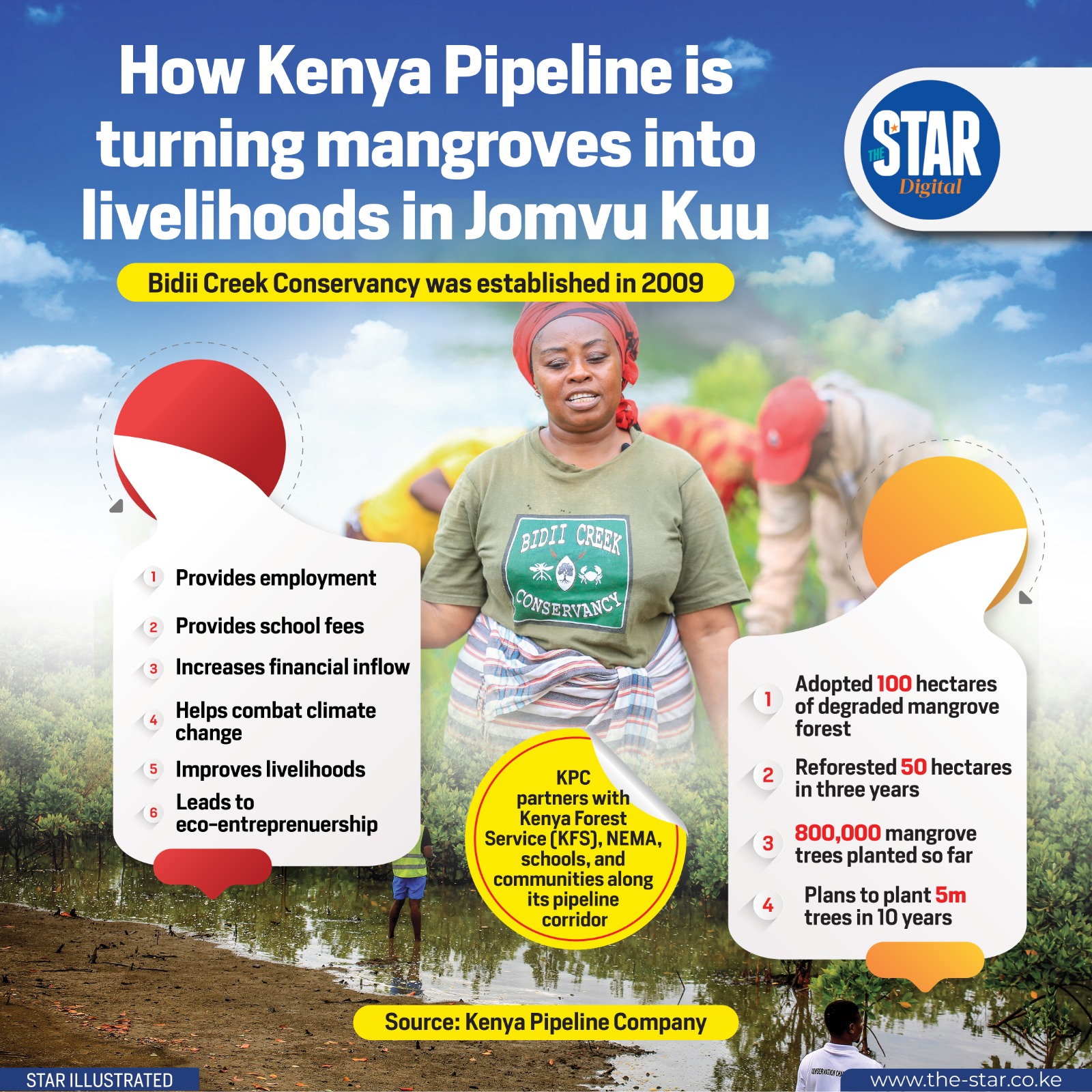
Community transformation rooted in mangroves
KPC Foundation channels at least 1 per cent of its profit‑before‑tax, capped at Sh150 million annually, into transformative initiatives across health, education, water, sports, and the environment.
The Jomvu mangrove restoration project has emerged as one of its signature environmental investments.
In the first phase, community members planted nearly 550,000 seedlings across 50 hectares.
As the foundation stated, “In environmental conservation, we focus on reforestation and afforestation.
In Jomvu Kuu, we’ve planted nearly 550,000 mangrove seedlings in the first phase. This effort not only rehabilitates the ecosystem but empowers the community economically.”
The second phase, which started in April this year, added another 243,000 seedlings toward restoring a total of 100 hectares.
Each seedling, sourced and nurtured locally, costs about Sh 100, covering nursery management, planting, pitting, and transport. That financial inflow has significantly reshaped livelihoods in Jomvu.
So far, KPC has planted about 800,000 mangroves in Jomvu Kuu along the Tudor Creek.
Livelihoods from forest regrowth
For Ali Machicha, chairman of Bidii Creek Conservancy, the mangrove project has done more than revive trees—it has revitalised lives.
“We’ve seen our members build homes, buy motorbikes (boda bodas), and even pay for university education for their children. All this has been made possible by mangrove conservation,” he says.
Machicha adds: “We’ve planted more than 700,000 seedlings since 2017. Mangroves are crucial in combating climate change and ensuring our coastline survives the rising tides.”
Membership in Bidii includes 25 core individuals—each with a transformation story.
One is Thima Ahmed, the treasurer of the group, who says: “I’ve built a four‑roomed house with my earnings from this project. I even bought a freezer to store fish and prawns, and I’m now able to send my children to school.”
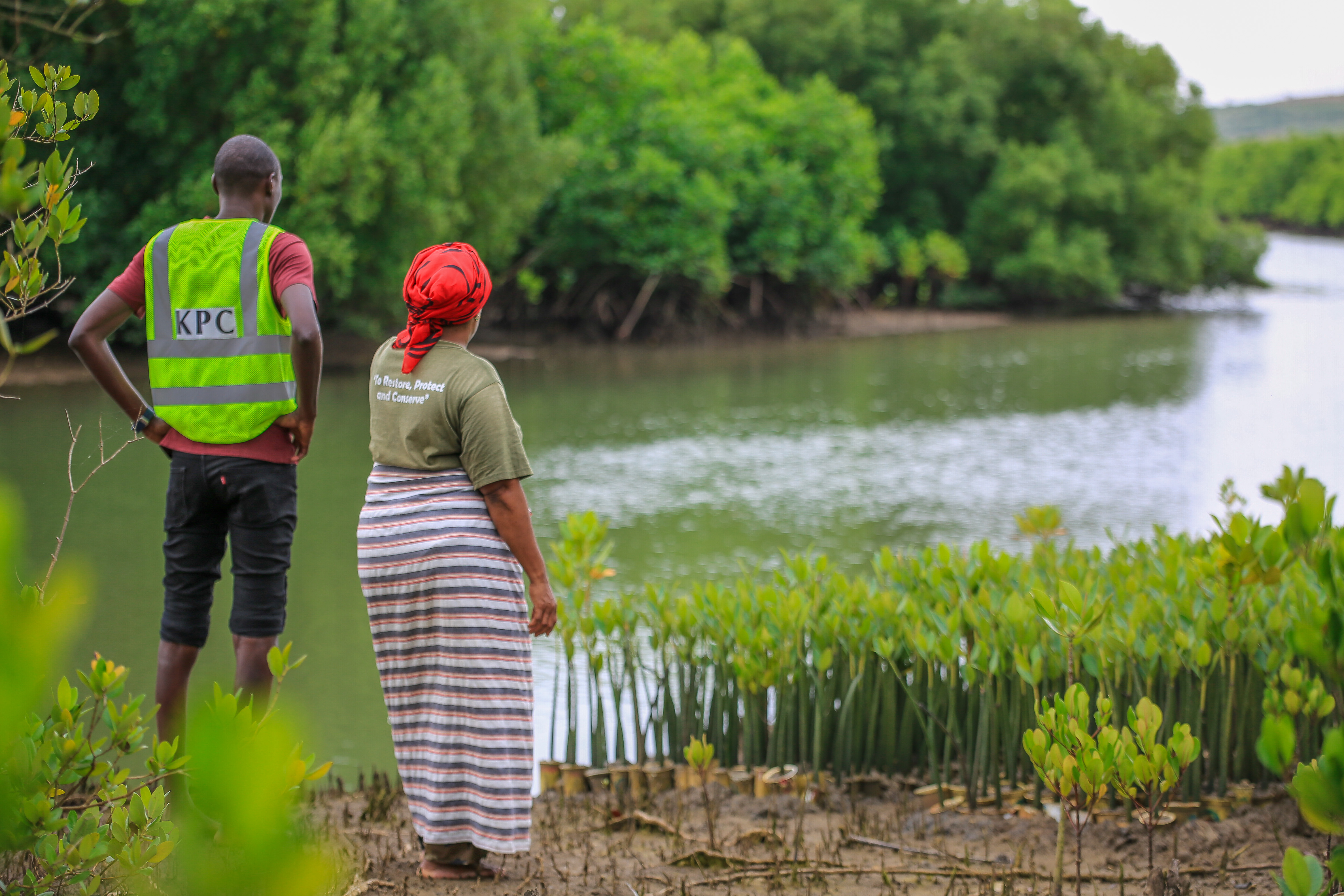 Treasurer Thima Ahmed inspecting the mangrove seedlings nursery in Jomvu Kuu along Tudor Creek on July 22, 2025./ PHOTO: John Chesoli
Treasurer Thima Ahmed inspecting the mangrove seedlings nursery in Jomvu Kuu along Tudor Creek on July 22, 2025./ PHOTO: John Chesoli“Our work is to take care of the mangrove nurseries. These seedlings feed families; one mangrove tree can support many households,” says Thima.
Beyond planting: eco‑entrepreneurship in action
Bidii Creek Conservancy has expanded its enterprise beyond seedlings into beekeeping. The group now manages 160 beehives in the mangrove forests; KPC donated 20 to jump‑start the venture, and at least 12 are now active.
Thima explains: “We’ve begun harvesting honey. For now, we sell it locally, but we hope to explore export markets in the future.” Income from honey and seedlings has allowed the group to acquire their own hives and tools.
Beekeeping complements restoration: pollinators support flowering vegetation; honey sales provide a steady income; and knowledge spreads among members, enhancing biodiversity and forest health.
Mangroves as frontline climate defenses
Mangroves are much more than coastal trees—they are nature’s bulwark. These salt‑tolerant forests absorb tidal surges, prevent shoreline erosion, sequester four times more carbon than tropical rainforests, and serve as critical nurseries for marine life.
Yet Kenya has lost over 40 per cent of its mangrove cover. Of the country’s 61,000 hectares of mangroves along the coast, about 4,000 hectares lie in Mombasa County—many already degraded.
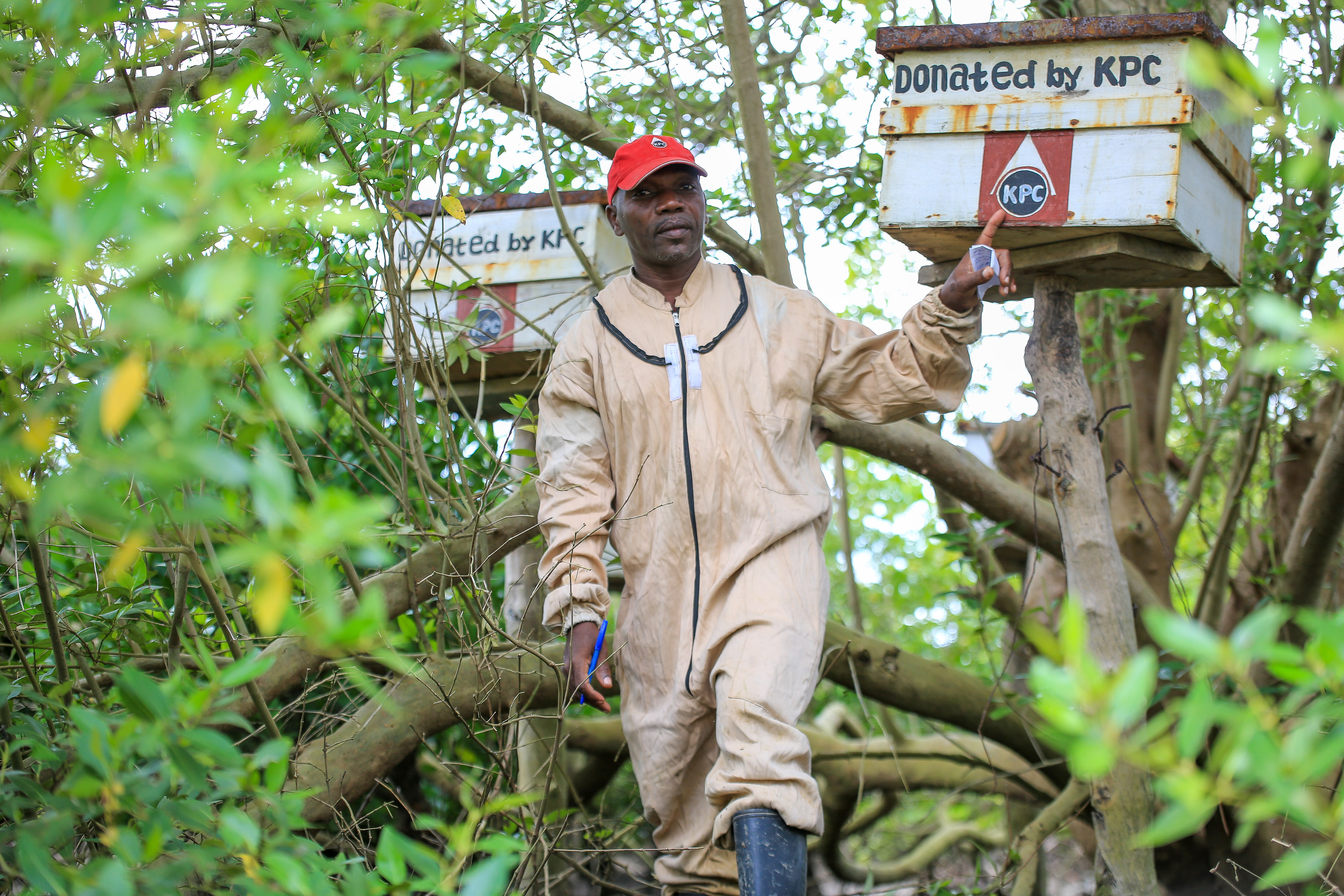 A member of Bidii Creek Conservancy showcases the beehives donated to the group by KPC on July 22, 2025./ PHOTO:John Chesoli
A member of Bidii Creek Conservancy showcases the beehives donated to the group by KPC on July 22, 2025./ PHOTO:John Chesoli In concert with these national efforts, Jomvu’s revived forest and community enterprise embody the concrete impact of policy and partnership in action.
Institutional partnerships deliver impact
KPC’s collaboration with KFS is formalised through a Memorandum of Understanding that obligates both parties to conserve public forests while securing pipeline zones traversing forest land.
According to Chief Conservator Alex Lemarkoko, synergy between institutions is vital—not just for restoration, but to protect critical infrastructure near forest areas.
KFS supports capacity building and increases ranger presence to ensure forest protection.
KPC’s environmental reporting emphasises the high survival rate of planted trees and their ambition to offset greenhouse gas emissions through carbon credit validation as part of its restoration work.
Celebrating international day for the conservation of the Mangrove ecosystem
As the world observed the International Day for the Conservation of the Mangrove Ecosystem on July 26, the Jomvu Kuu community stood as a beacon of what community‑led restoration can deliver with institutional backing.
On this day, Bidii Creek Conservancy members were actively planting more mangrove seedlings along Tudor Creek to commemorate the occasion.
Their continued work underscores how local stewardship, backed by corporate environmental investment, can nurture both ecosystems and economic opportunity.
Challenges ahead and the road to sustainability
Despite the clear successes, challenges remain. Training, tools, and exposure are needed to scale up both conservation work and value‑added enterprises.
Honey harvest operations aim to grow into broader markets; the group is exploring carbon credit certification to secure long‑term revenue streams.
KPC has also invested in training Beach Management Units, assisting members to find employment locally and abroad as part of a broader empowerment strategy.
A model for community‑driven conservation
On the International Day for Mangrove Conservation, the people of Jomvu Kuu offer a powerful example: mangrove restoration need not be an environmental sidebar—it can drive community resurgence.
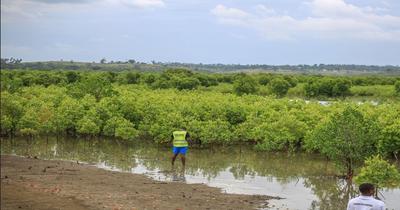 A section of the 50 hectares of mangroves that have been planted by Bidii Creek Conservancy in Jomvu with the assistance of KPC on July 22, 2025/PHOTO:John Chesoli
A section of the 50 hectares of mangroves that have been planted by Bidii Creek Conservancy in Jomvu with the assistance of KPC on July 22, 2025/PHOTO:John ChesoliAs Kenya advances toward its 2027 mangrove restoration goals and its vision of 30 per cent tree cover by 2032, initiatives like Jomvu Creek serve as living proof that national policy and local ownership can together turn restoration into resilience—and rebuilding into livelihood.











